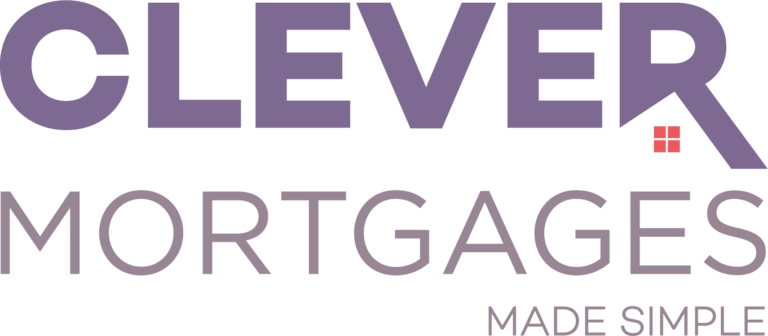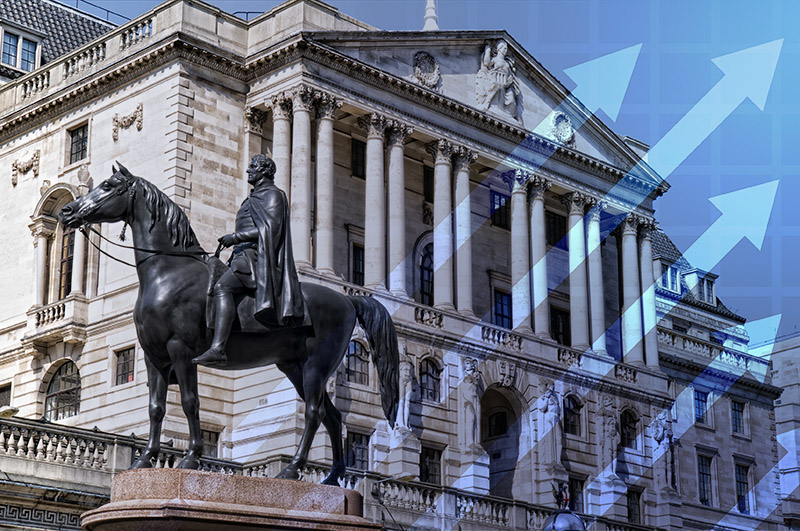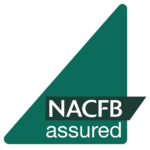Interest rates have increased to the highest level since 2009 as the Bank of England tries to tackle the rising cost of living.
Rates rose from 0.75% to 1%, the fourth consecutive increase since December.
Inflation is rising at its fastest rate for 30 years, with fuel, energy and food costs soaring in part because of the Ukraine war.
With energy bills soaring and the weekly shop making a bigger dint in our wallets, the financial squeeze on UK households is seemingly just beginning. The inflation rate is currently sitting at 5.4%, and The Bank of England forecast it hitting a staggering 7.25% in April – a far cry from the 2% target set out by the MPC.
Talk to us today to secure your fixed rate remortgage or product transfer.
How does the bank rate affect interest rates?
The Bank of England’s base rate is one of the biggest financial influences in the country, setting the interest rate that most commercial banks will end up charging customers. The MPC votes on the rate around eight times a year, but they reserve the power to make changes as and when is needed. The BoE uses this rate to steer UK spending;
Increasing the rate: this makes borrowing more expensive but makes saving more attractive – triggering the UK population to decrease spending, which in turn helps decrease inflation.
Lowering the rate: this works the other way, making borrowing cheaper and saving less attractive, triggering more spending and less saving, this can help the MPC raise inflation and meet their 2% target to ensure healthy economic growth.
How does the interest rate rise affect me?
The base rate rise is likely to have some impact on all of us, affecting the rate we pay for mortgages, car loans, credit cards and more. The increase means the cost of borrowing money will increase, and those who are already in agreements outside of a fixed rate will see a rise in their outgoings.
On the other hand, those with savings should finally start seeing some returns after a considerable time of sedation, assuming the increase is passed on to savers.
Interest rates have risen .25% with more rises predicted over the next year. We have highlighted below what your mortgage payments would rise by over 1%.
Now could be the time to talk to us about a remortgage or product transfer to lock in your monthly payments.
Example
| Current mortgage | Term | Rate | Monthly payment | +0.25% | +0.5% | +1% |
| £100,000 | 20 years | 2% | £505.88 | £517.81 | £529.90 | £554.60 |
| £150,000 | 20 years | 2% | £758.83 | £776.71 | £794.85 | £831.90 |
| £200,000 | 20 years | 2% | £1,011.77 | £1,035.62 | £1,059.81 | £1,109.20 |
| £250,000 | 20 years | 2% | £1,264.71 | £1,294.52 | £1,324.76 | £1,386.49 |
| £300,000 | 20 years | 2% | £1,517.65 | £1,553.42 | £1,589.71 | £1,663.79 |
| £400,000 | 20 years | 2% | £2,023.53 | £2,071.23 | £2,119.61 | £2,218.39 |
| Current mortgage | £100,000 |
| Term | 20 years |
| Rate | 2% |
| Monthly payment | £505.88 |
| +0.25% | £517.81 |
| +0.5% | £529.90 |
| +1% | £554.60 |
| Current mortgage | £150,000 |
| Term | 20 years |
| Rate | 2% |
| Monthly payment | £758.83 |
| +0.25% | £776.71 |
| +0.5% | £794.85 |
| +1% | £831.90 |
| Current mortgage | £200,000 |
| Term | 20 years |
| Rate | 2% |
| Monthly payment | £1,011.77 |
| +0.25% | £1,035.62 |
| +0.5% | £1,059.81 |
| +1% | £1,109.20 |
| Current mortgage | £250,000 |
| Term | 20 years |
| Rate | 2% |
| Monthly payment | £1,264.71 |
| +0.25% | £1,294.52 |
| +0.5% | £1,324.76 |
| +1% | £1,386.49 |
| Current mortgage | £300,000 |
| Term | 20 years |
| Rate | 2% |
| Monthly payment | £1,517.65 |
| +0.25% | £1,553.42 |
| +0.5% | £1,589.71 |
| +1% | £1,663.79 |
| Current mortgage | £400,000 |
| Term | 20 years |
| Rate | 2% |
| Monthly payment | £2,023.53 |
| +0.25% | £2,071.23 |
| +0.5% | £2,119.61 |
| +1% | £2,218.39 |
How will the rise affect my mortgage?
Indications are that the base rate is set to continue rising well into 2023, and although UK homeowners holding variable rate mortgages are now facing more expensive repayments, they should anticipate these costs increasing as the rate does.
Tracker mortgages: Tracker mortgages ‘track’ the Bank of England base rate with an additional percentage tacked on to ensure the lender makes a return. Similar, to other mortgage products, the tracker rate is often offered for a set period of time before moving onto the lenders standard variable rate (SVR), normally 2 to 3 years.
Tracker mortgages: carry an element of risk, as the interest rate could go up or down and this results in an immediate change to the monthly mortgage payment. Since the Bank of England base rate has increased, those on a tracker product will now have a higher monthly mortgage payment and this could continue over the coming years.
Standard Variable Rate (SVR) mortgages: Generally speaking, SVR rates are the interest rates homeowners revert to once an initial mortgage rate has ended, usually after 2 to 5 years of the mortgage. The SVR is set by the lender and unless you’re on a deal, it’s likely this is the rate you’ll be paying. SVR mortgages can work out more expensive than other mortgage products and the lender can raise or lower the rate as they see fit. The base rate rise may not see you paying as much as a tracker mortgage, but repayments are likely to go up in cost for SVR mortgages and this will only increase over time.
It’s fairly commonplace for homeowners to remortgage when approaching the end of an initial mortgage product, and with the base rate not going down any time soon it’s wise to check if you’re really getting the best deal available.
Discount mortgages: Discount mortgages offer interest rates slightly below the lenders SVR for a set term, but if the SVR goes up then so do the repayments. Again, the variability of this mortgage type means homeowners are going to be forking out more to meet their monthly repayments.
Fixed-rate mortgages: Fixed-rate mortgages create a brief respite from the financial turmoil, offering a stable and secured rate over a set period of years, this means your mortgage payment is known. UK homeowners currently on fixed-rate mortgages shouldn’t expect to see an increase in repayments, but those approaching the end of their fixed term should seek to speak to an expert about securing a product transfer or remortgage deal before the base rate rises again. With the cost of borrowing going up, locking in a deal sooner rather than later could wind up saving you a fair chunk. You can talk to a mortgage broker up to 6 months before your mortgage product is due to expire.
What should I do if I’m worried about my mortgage repayments?
With inflation driving up the price of daily living, it’s worth looking at your mortgage, the deal you’re getting and what you can afford before rates rise again – this could be the last chance to get a cheaper fixed-rate that homeowners will see for a while.
If you’re on a variable interest rate, or coming to the end of your fixed-term you might be wondering what options you have. Not everyone can afford to budget bills that flux, and with many of us still recovering from the financial strains of the pandemic the idea of skyrocketing mortgage repayments can feel daunting.
As such, finding and securing a remortgage or product transfer with a fixed-rate could be the best way to start protecting your finances and keeping stability. This again can seem daunting, but our expert advisors and brokers are more than happy to help you find the mortgage that’s right for you- guiding you through the process and making sure you get the best deal on the market.
Remortgage vs Product transfer:
Remortgaging entails finding a new lender and taking out a new mortgage, repaying your old one and beginning repayments to your new lender. This can help homeowners access better deals and rates, especially if a chunk of the previous mortgage has already been paid off. Some people remortgage to raise additional funds, some remortgage because a fixed term deal is ending and others simply wish to find a better deal – there are countless reasons someone might choose to remortgage but the process remains largely the same.
Product transfers have been around for a while, but became quite popular during the pandemic when a lot of homeowners came to the end of a fixed-term deal while on payment holiday. Unlike remortgages, you stay with the same lender but move onto a new product. Again, you don’t always know if you’re getting the best deal when only looking at one lender so it’s still wise to get advice to make sure you’re making the right choice.
Although now may be the best time to switch, it’s still important to bear in mind lenders still have their own criteria and affordability check to adhere to before they’re able to decide on a mortgage application. The rates you could be offered will be based on a range of factors, such as your credit history, income and expenditure, the loan to value (LTV) ratio of your property and how much you’re looking to borrow. Expert advice is worth its weight in gold here, helping you wade through the countless deals and finding the lenders that are most likely to accept your application, preventing rejections harming your credit score and mortgage chances.
Representative Example:
Mortgage amount £170,995 (including £995 lender fee), 64 payments of £748.30 at a fixed interest rate of 2.28%, followed by 236 payments of £889.60 at a variable rate of 4.24%. Over a term of 25 years, giving a total amount payable of £258,861 at an APRC of 3.6%. The contract will be secured against your property.



